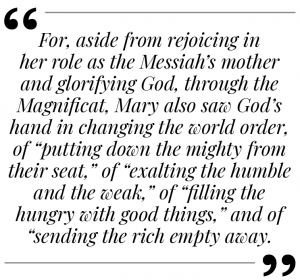By H. Marcos C. Mordeno
 MALAYBALAY CITY (MindaNews) – Contemporary practice pictures the Virgin Mary as the docile mother of The Christ. If I recall correctly, the only times she was mentioned in the New Testament were during her visitation to her cousin Elizabeth, the birth of her son and the escape from the murderous intent of King Herod, the wedding at Cana, and during the Passion and Resurrection.
MALAYBALAY CITY (MindaNews) – Contemporary practice pictures the Virgin Mary as the docile mother of The Christ. If I recall correctly, the only times she was mentioned in the New Testament were during her visitation to her cousin Elizabeth, the birth of her son and the escape from the murderous intent of King Herod, the wedding at Cana, and during the Passion and Resurrection.
That Mary witnessed Christ’s ascension is part of the catechism of the Roman Catholic Church as well as of the Orthodox tradition.
However, the Gospels omit Mary’s role in her son’s formation as someone who would expose and challenge the hypocrisy of the Pharisees and Sacerdotes, their pretensions to superior sanctity, and the social injustices engendered by Roman imperialism.
Her image is confined to that of a protective mother who, along with husband Joseph, shielded Christ from physical harm, and a woman grieving on Golgotha for a son who died from crucifixion, the worst punishment inflicted on those who defied Roman rule.
I’d venture that Mary served as Christ’s role model and inspiration when it comes to his political views. I can offer no scholastic, much less biblical, evidence to that. But a closer reading of the Magnificat (Mary’s Song or My Soul in Latin), which is found in Luke’s Gospel, suggests that she isn’t the meek, passive symbol of the Church she is portrayed to be.
For, aside from rejoicing in her role as the Messiah’s mother and glorifying God, through the Magnificat, Mary also saw God’s hand in changing the world order, of “putting down the mighty from their seat,” of “exalting the humble and the weak,” of “filling the hungry with good things,” and of “sending the rich empty away.”
The terms “revolution” and “class struggle” would emerge centuries after Christ’s death. But what can be more revolutionary than Mary’s Song?
Is this why Pope Francis declared that the Church is a woman?
(MindaViews is the opinion section of MindaNews. H. Marcos C. Mordeno can be reached at hmcmordeno@gmail.com.)


